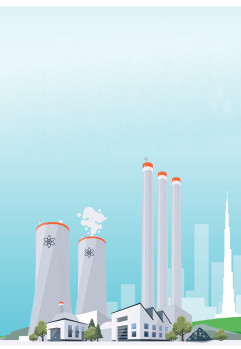Powering Ahead
The UAE boasts a long list of firsts in the Gulf region, but the development of a nuclear power plant rising in Abu Dhabi is among its crowning achievements in its efforts to combat climate change.
Currently under construction, the UAE’s Barakah Nuclear Energy Plant will have four nuclear reactors that will boost civil nuclear power capacity in the country and help diversify its energy sources, which currently heavily rely on natural gas.
Emirates Nuclear Energy Corporation, along with prime contractor Korea Electric Power Corporation (KEPCO), is building the four reactors simultaneously in the Al Dhafra region of Abu Dhabi, approximately 53 kilometres west-southwest of the city of Ruwais. Construction began in July 2012 and the project is expected to be completed by 2020, after which it will deliver up to a quarter of the UAE’s electricity needs, as well as saving up to 12 million tonnes in carbon emissions every year.
“The development of peaceful nuclear energy is supporting the diversification of the UAE’s energy mix and has already created solid value across many strategic sectors in the UAE and internationally,” said His Excellency Eng. Mohamed Al Hammadi, Chief Executive Officer of ENEC. “Nuclear energy has a key role to play in the UAE Energy Plan 2050, which aims to cut carbon dioxide emissions by 70%, increase clean energy use by 50%, and improve energy efficiency by 40% by the middle of the century.”
The move by Abu Dhabi is part of the UAE’s Energy Strategy to raise the contribution of clean energy in the total energy mix to 50%, which will lead to savings of AED700 billion by 2050, and generate investments of USD600 billion in the UAE.
“The new strategy takes into consideration an expected annual growth of 6%, and efforts to increase the contribution of clean energy in the energy mix from 25% to 50% by 2050, apart from the reduction of the carbon footprint resulting from power generation by 70% over the next three decades,” said Vice President and Prime Minister of the UAE, and Ruler of Dubai, His Highness Sheikh Mohammed bin Rashid Al Maktoum.
“He who does not think about energy is not thinking about the future,” he added.
Indeed, nuclear energy is central to the UAE and the world’s efforts to combat climate change. Close to 200 countries, including the UAE, signed the Paris Agreement in 2015 to limit the global temperature rise to well below 2 degrees Celsius above pre-industrial levels and to pursue efforts to limit the temperature increase even further to 1.5 degrees Celsius.
“Additionally, the agreement aims to strengthen the ability of countries to deal with the impacts of climate change. To reach these ambitious goals, appropriate financial flows, a new technology framework and an enhanced capacity building framework will be put in place, thus supporting action by developing countries and the most vulnerable countries, in line with their own national objectives,” states the agreement.
Nuclear energy is considered to be a low-emitting source of electricity production, second only to hydropower, and generated around 30% of all low-carbon electricity generated in 2016, according to studies.
“While a variety of low- or zero-carbon technologies can be employed in various combinations, our analysis shows the potential contribution nuclear can make as a dispatchable low-carbon technology. Without that contribution, the cost of achieving deep decarbonisation targets increases significantly,” according to a study by the Massachusetts Institute of Technology.
On a global scale, nuclear power currently reduces carbon dioxide emissions by some 2.5 billion tonnes per year relative to the main alternative of coalfired generation, and about 2 billion tonnes relative to the present fuel mix, according to the World Nuclear Association.
“The development of peaceful
nuclear energy is supporting
the diversification of the
UAE’s energy mix and has
already created solid value
across many strategic
sectors in the UAE and
internationally”
HIS EXCELLENCY ENG. MOHAMED
AL HAMMADI, CEO, ENEC
“Nuclear power has a key role to play in reducing greenhouse gases,” WNA said.
While some environmentalists are against including nuclear energy as a complementary energy source to renewable energy, the International Energy Agency believes it’s vital to lowering the temperature of the warming planet.
The International Energy Agency’s latest report, World Energy Outlook for 2018, notes that nuclear can help the world meet its 2-degree target, and forecasts nuclear energy generation to nearly double to 1,293 million tonnes of oil equivalents, from its current level of 688 mtoe, if the world pursues the Sustainable Development Scenario path.
The IEA’s Sustainable Development Scenario provides an integrated strategy to achieve energy access, air quality and climate goals, with all sectors and low-carbon technologies – including carbon capture, utilisation and storage – contributing to a broad transformation of global energy.
If countries proceed with the sustainable model, nuclear could generate 4,960 terrawatt per hour of electricity by 2040, or 13% of the world’s energy source, compared to its current level of 2,637 TWh, or roughly 10% of the world’s energy source. Nuclear will eclipse coal to become the fifth largest energy source after wind and solar, hydro and natural gas.
“While a variety of low- or
zero-carbon technologies
can be employed in various
combinations, our analysis
shows the potential
contribution nuclear can
make as a dispatchable
low-carbon technology.
Without that contribution,
the cost of achieving deep
decarbonisation targets
increases significantly”
STUDY BY THE MASSACHUSETTS
INSTITUTE OF TECHNOLOGY
FUTURE PATH
Nuclear energy had been in ascendancy over the past 50 years, but the tsunami in the Pacific Ocean in 2011 that damaged the Fukushima Daiichi nuclear plant in Japan cast a pall over the future of the industry.
The next few years would be vital for the nuclear energy industry: some two-thirds of today’s nuclear fleet in advanced economies is more than 30 years old and decision to extend, or shut down, this capacity will have significant implications for energy security, investment and emissions.
While developed economies are slow to launch new nuclear projects, emerging economies such as China, the UAE and Saudi Arabia are looking to revive the nuclear energy sector.
About two-thirds of the 60GW of nuclear power capacity currently under construction are expected to be completed by 2020, of which two-thirds is in Asia Pacific, with almost half in China alone.
“There are close to 20 countries developing new projects and raising the share of nuclear in electricity supply, including China, India, Russia, the United Arab Emirates and Saudi Arabia,” according to the IEA. “In addition, Canada and the United States have indicated that they intend to maintain the current role of nuclear power in electricity supply.”
With its Barakah Nuclear Energy Plant, the UAE is once again at the forefront of tackling climate change.
MYTH Radiation does not occur naturally.
FACT There are both natural and artificial sources of radiation that we live with safely every day. Cosmic radiation from the sun is an example of natural radiation. Examples of artificial radiation include medical x-rays and kitchen microwaves.
MYTH Nuclear energy facilities are not safe.
FACT The performance records of hundreds of nuclear energy facilities operating in more than 30 countries have demonstrated that nuclear energy is safe. The World Association of Nuclear Operators (WANO) tracks data on plant performance, including safety system performance, fuel reliability and industrial accident rates.
MYTH Nuclear reactors can explode like bombs.
FACT It is not possible for a nuclear energy plant to explode like a bomb because the enrichment level of the uranium is too low. Nuclear energy plants are designed to produce electricity safely and reliably.
MYTH Growth of the nuclear energy industry has stalled.
FACT Nuclear energy is rapidly expanding on a global scale. According to the World Nuclear Association (WNA), more than 60 plants are under construction in 15 countries.
MYTH Nuclear energy provides only a small amount of electricity.
FACT According to the Nuclear Energy Institute (NEI), 30 countries worldwide operate over 400 nuclear reactors for electricity. Further, nuclear energy plants provide nearly 11% of the world’s electricity and 13 countries relied on nuclear energy to provide at least 25% of their total electricity.
MYTH Nuclear energy facilities cannot safely manage used nuclear fuel.
FACT For decades, countries around the world have safely managed used nuclear fuel. In the UAE, the government is currently reviewing long-term storage options.
MYTH Nuclear energy is bad for the environment.
FACT Because nuclear energy facilities do not burn fossil fuels, they do not emit carbon gases. In the UAE, the introduction of nuclear energy will help our nation to achieve its climate change targets by saving up to 12 million tonnes of carbon emissions every year.
THE PARIS CLIMATE AGREEMENT: KEY POINTS
THE HISTORIC PACT, APPROVED BY 195 COUNTRIES, WILL TAKE EFFECT FROM 2020
TEMPERATURES 2100 Keep warming “well below 2 degrees Celsius”. Continue all efforts to limit the rise in temperatures to 1.5 degrees Celsius.
FINANCE 2020 - 2025 Rich countries must provide $100 billion from 2020, as a “floor”. Amount to be updated by 2025.
DIFFERENTIATION Developed countries must continue to “take the lead” in the reduction of greenhouse gases. Developing nations are encouraged to enhance their efforts”.
EMISSIONS OBJECTIVES 2050 Aim for greenhouse gases emissions to peak “as soon as possible”. From 2050: rapid reductions to achieve a balance between emissions from human activity and the amount that can be captured by “sinks”.
BURDEN-SHARING Developed countries must provide financial resources to help developing countries. Other countries are invited to provide support on a voluntary basis.
REVIEW MECHANISM 2023 A review every five years. First world review: 2023. Each review will inform countries in “updating and enhancing” their pledges.
CLIMATE DAMAGE Vulnerable countries have won recognition of the need for “averting, minimising and addressing” losses suffered due to climate change.








